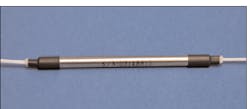Fiber Optic Polarizers are designed to polarize the output from a light source or fiber and launch it into an output fiber. These polarizers typically consist of input and output collimators with a plate polarizer in between. Broadband polarizers are used, so the power extinction ratio is maintained for up to several hundreds of nanometers. The same polarizer, for example, may be used for 1300nm to 1600nm. The power extinction ratio is the ratio between maximum and minimum output power as the input polarization state is changed. This is different from the output polarization extinction ratio, which is a measure of the ratio between the power in the two axes of polarization maintaining fiber. This value is dependent upon the extinction ratio of the polarizer, the alignment of the output fiber axes to the polarizer and the extinction ratio of the output fiber. When an output extinction ratio is specified, it is the polarization extinction ratio. This value is only applicable when the output fiber is polarization maintaining fiber. The power extinction ratio will always equal exceed the polarization extinction ratio.
